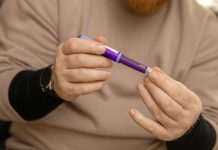
What are Electrochemical Biosensors?
To understand this exciting development, let’s first take a step back and talk about what electrochemical biosensors are.
These are tools that work on a biological level to detect specific substances in samples. They do this through biomolecules, which are substances like enzymes and antibodies.
In the world of biosensors, these biomolecules are known as bioreceptors. They play a crucial role in identifying substances in a given sample.
Once a bioreceptor finds a substance it can recognize, it generates an electrical signal.
This signal is more than just a simple alert. It can provide detailed information about the substance, including what it is and how much of it is present.
For instance, consider how we measure blood glucose levels. An electrochemical sensor uses an enzyme that can selectively recognize glucose.
However, this kind of sensor typically requires a dedicated electrode and a device to manage the reaction that takes place at the electrode.
A New Player in the Game: Biofuel Cell on a Chip
Now, let’s dive into the recent research that’s shaking things up in the field of electrochemical biosensors. In this study, researchers used a biofuel cell on a chip as a sensor.
This innovative design allows the enzyme and glucose reaction to occur without needing an external device or power source.
So, how does it work? The process is surprisingly straightforward. First, a few microliters of blood (just to put it in perspective, a microliter is one-millionth of a liter) are dropped onto the chip.
Then, the reaction between the enzyme and the glucose in the blood starts automatically.
The current flowing between the two electrodes of the biofuel cell is then measured. This measurement provides the blood glucose level.
What’s even more exciting is how this data can be read. Instead of needing specialized equipment, general-purpose devices like smartphones can do the job.
The research was published in the journal Biosensors and Bioelectronics.
Looking Ahead: The Future of Biosensors
This innovative approach to biosensor design opens up a world of possibilities.
By changing the enzyme based on what substance needs to be measured, it is conceivable that we could develop disposable sensors that can detect various biomarkers.
Biomarkers are biological molecules found in blood, other body fluids, or tissues that are a sign of a normal or abnormal process, or of a condition or disease.
They could be cholesterol level for heart disease, blood sugar for diabetes, or specific proteins for cancers.
Having a simple, cheap, and disposable sensor that could detect a wide range of these biomarkers would be a significant advancement in the field of medicine.
It would allow for more frequent testing, early detection of diseases, and improved patient outcomes.
Imagine a world where you could use your smartphone to monitor a range of health conditions regularly. You could catch potential health issues earlier and manage existing ones better.
This study is a significant step in that direction, pushing the boundaries of what’s possible with biosensor technology.
By integrating biosensors with everyday devices, we’re moving towards a future where sophisticated health monitoring is within everyone’s reach.
The study was published in Biosensors and Bioelectronics.
Copyright © 2023 Knowridge Science Report. All rights reserved.



